The Australian Bureau of Meteorology deleted what was long regarded as the hottest day ever recorded in Australia – Bourke’s 125°F (51.7°C) on the 3rd January 1909. This record* was deleted, falsely claiming that this was likely some sort of ‘observational error’, as no other official weather stations recorded high temperatures on that day.
However, Craig Kelly MP has visited the Australian National Archive at Chester Hill in western Sydney to view very old meteorological observation books. It has taken Mr Kelly MP some months to track down this historical evidence. Through access to the archived book for the weather station at Brewarrina, which is the nearest official weather station to Bourke, it can now be confirmed that a temperature of 50.6°C (123°F) was recorded at Brewarrina for Sunday 3rd January 1909. This totally contradicts claims from the Australian Bureau of Meteorology that only Bourke recorded an extraordinarily hot temperature on that day.
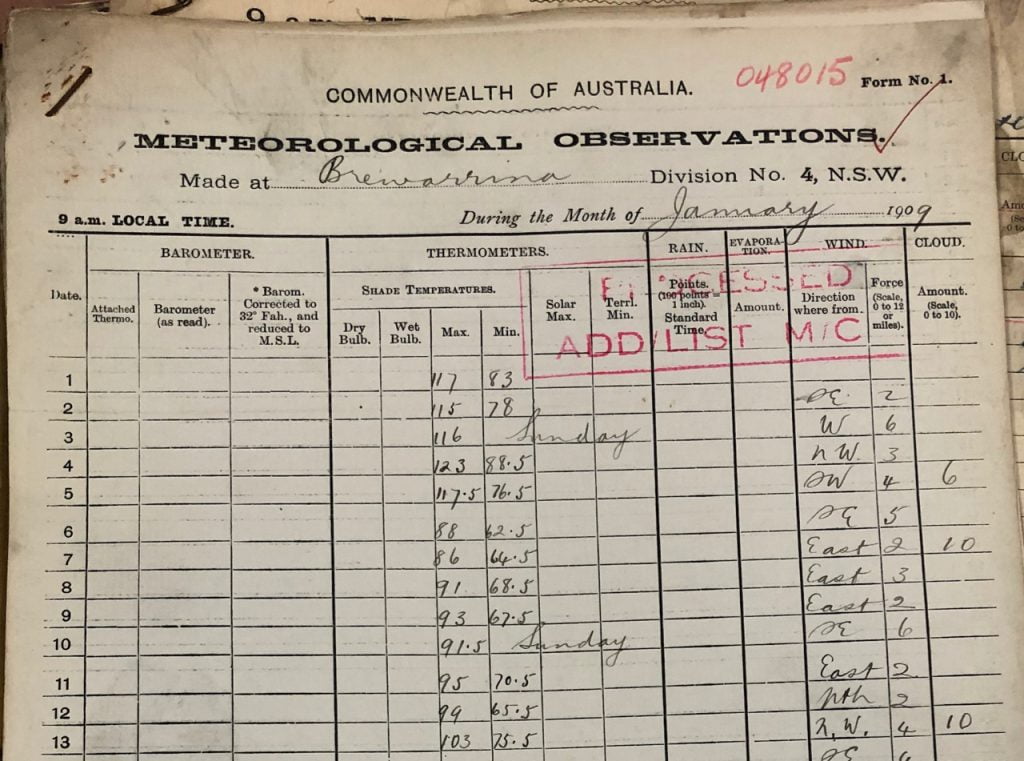
Just today, Friday 10th July 2020, Mr Kelly MP obtained access to this record for Brewarrina, the closest official weather station to the official weather station at Bourke.
He has photographed the relevant page from the observations book, and it shows 123°F was recorded at 9am on the morning of Monday 4th January 1909 – published here for the first time. This was the highest temperature in the previous 24 hours and corroborates what must now be recognised as the hottest day ever recorded in Australia of 51.7°C (125°F) degrees at Bourke on the afternoon of Sunday 3rd January 1909.
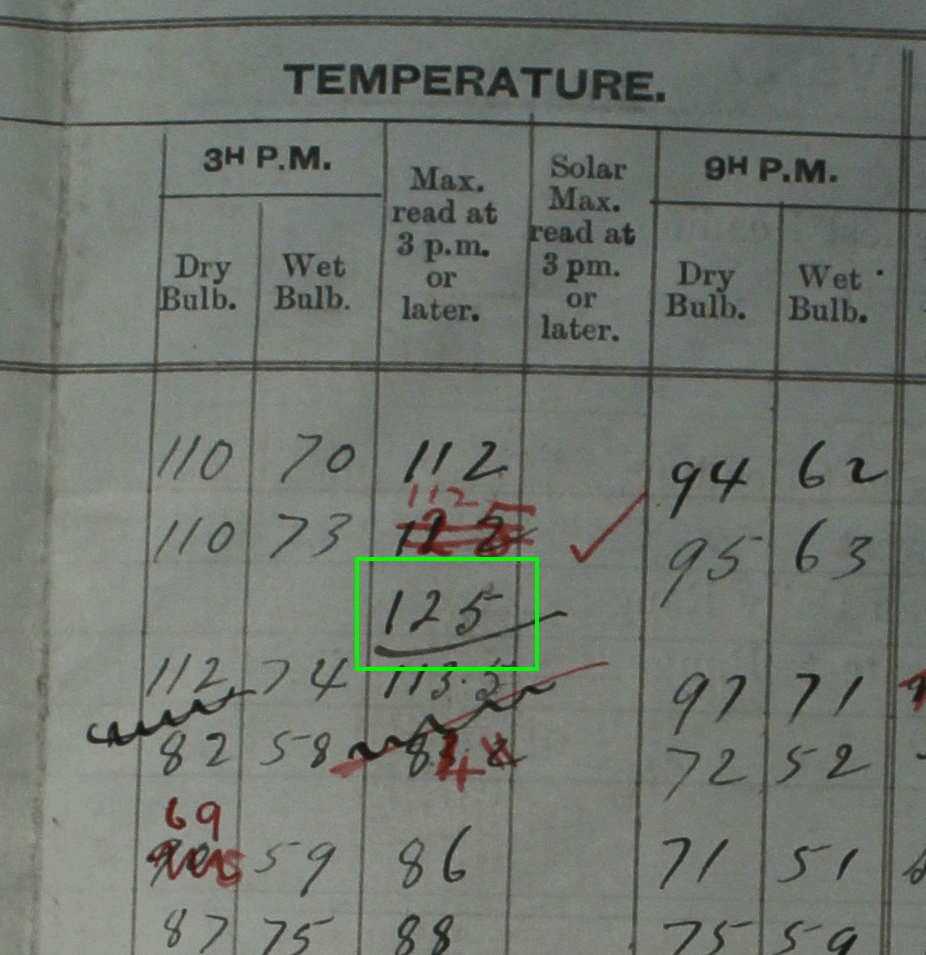
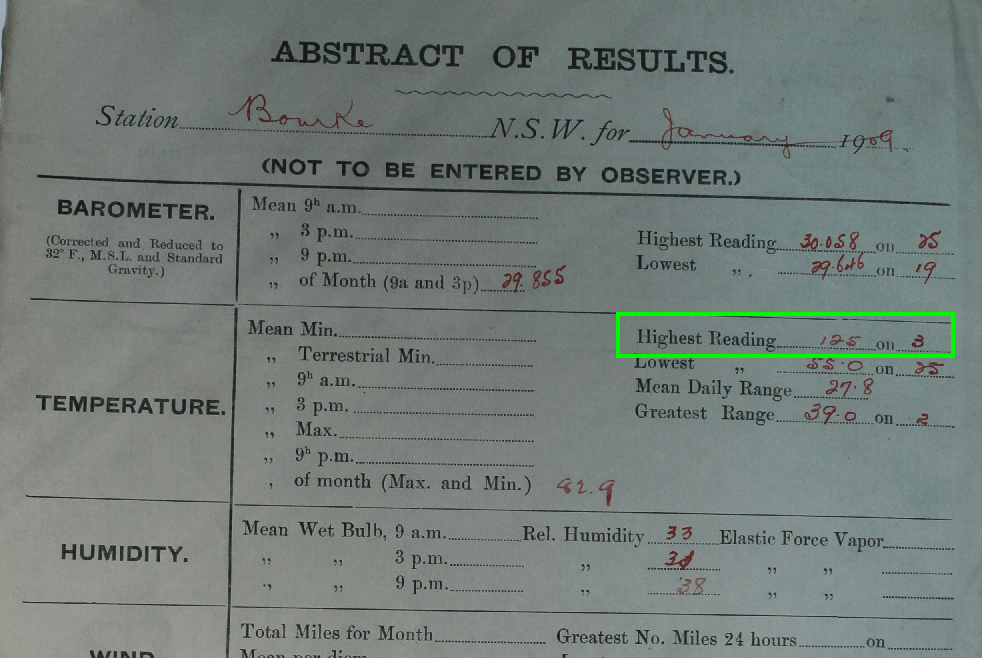
These images are from more complete pages that were photographed and can be accessed here: https://jennifermarohasy.com/reinstate-hottest-day/
That the Bureau of Meteorology denies these record hot days is a travesty. Is it because these records contradict their belief in catastrophic human-caused global warming?
The temperature of 50.6°C (123°F) recorded back in 1909 which is more than 100 years ago, photographed by Mr Kelly today at the National Archives in Chester Hill, is almost equivalent to the current official hottest day ever for Australia of 50.7 degrees Celsius at Oodnadatta on 2nd January 1960. These are in fact only the fourth and third hottest days recorded in Australia, respectively.
Not only has Mr Kelly MP tracked-down the meteorological observations book for Brewarrina, but over the last week he has also uncovered that 51.1°C (124°F) was recorded at White Cliffs for Wednesday 11th January 1939. This is the second hottest ever!
The evidence, a photograph from the relevant page of the White Cliff’s meteorological observations book, is published here for the first time.
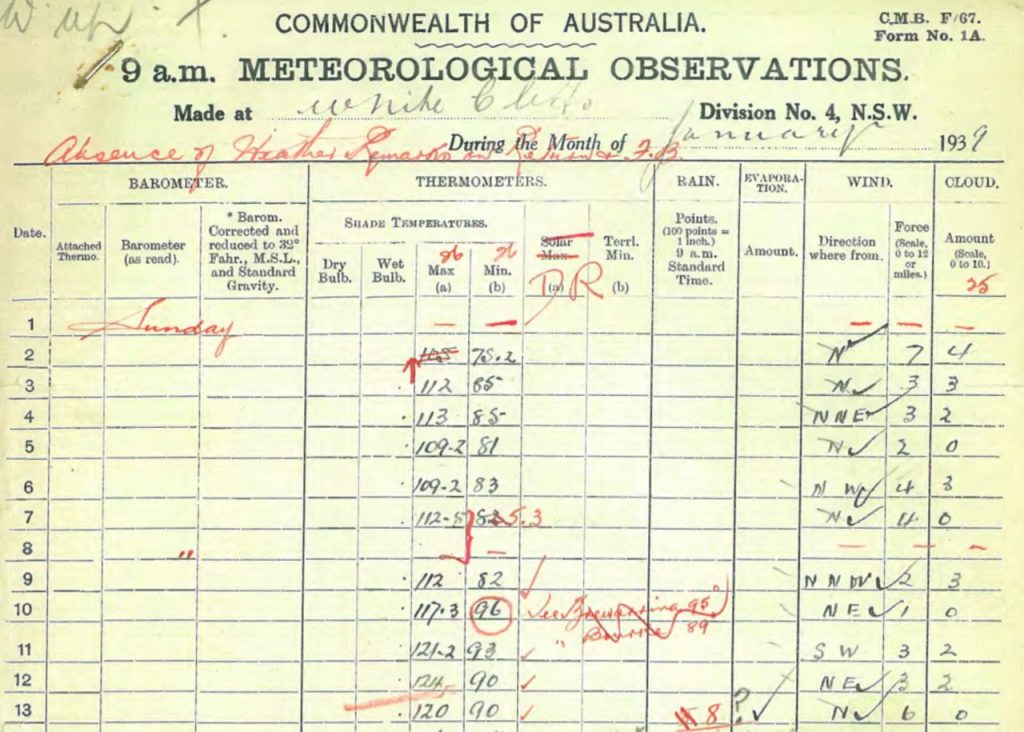
Until the efforts of Mr Kelly MP, this second hottest-ever record was hidden in undigitised archives.
It is only through the persistence of Mr Kelly to know the temperatures at all the official weather stations in the vicinity of Bourke that this and other hot days have been discovered.
If we are to be honest to our history, then the record hot day at Bourke of 51.7°C (125°F) must be re-instated, and further the very hot 50.6°C (123°F) recorded for Brewarrina on the same day must be entered into the official databases.
Also, the temperature of 51.1°C (124°F) recorded at White Cliffs on 12th January 1939 must be recognised as the second hottest ever.
For these temperatures to be denied by the Bureau because they occurred in the past, before catastrophic human-caused global warming is thought to have come into effect, is absurd.
At a time in world history when Australians are raising concerns about the Chinese communist party removing books from Libraries in Hong Kong, we should be equally concerned with the Australian Bureau of Meteorology removing temperature records from our history.
If global warming is indeed the greatest moral issue of our time, then every Australian regardless of their politics and their opinion on greenhouse gases and renewable energies, must be honest to history and these truths.
____
* This temperature (125°F/51.7°C on the 3rd January 1909) was recorded at an official Bureau weather station and using a mercury thermometer in a Stevenson screen. Hotter temperatures were recorded in 1896 but the mercury thermometers were not in Stevenson screens, which is considered the standard for housing recording equipment.
The feature image shows Craig Kelly MP at The Australian National Archive, Chester Hill, just today examining the Brewarrina Meteorological Observations book.
The following YouTube video is of me being interviewed on Sky Television by Chris Smith last December 2019.
I have previously blogged on the record hot day at Bourke being deleted by the Bureau here:
https://jennifermarohasy.com/2017/02/australias-hottest-day-record-ever-deleted/

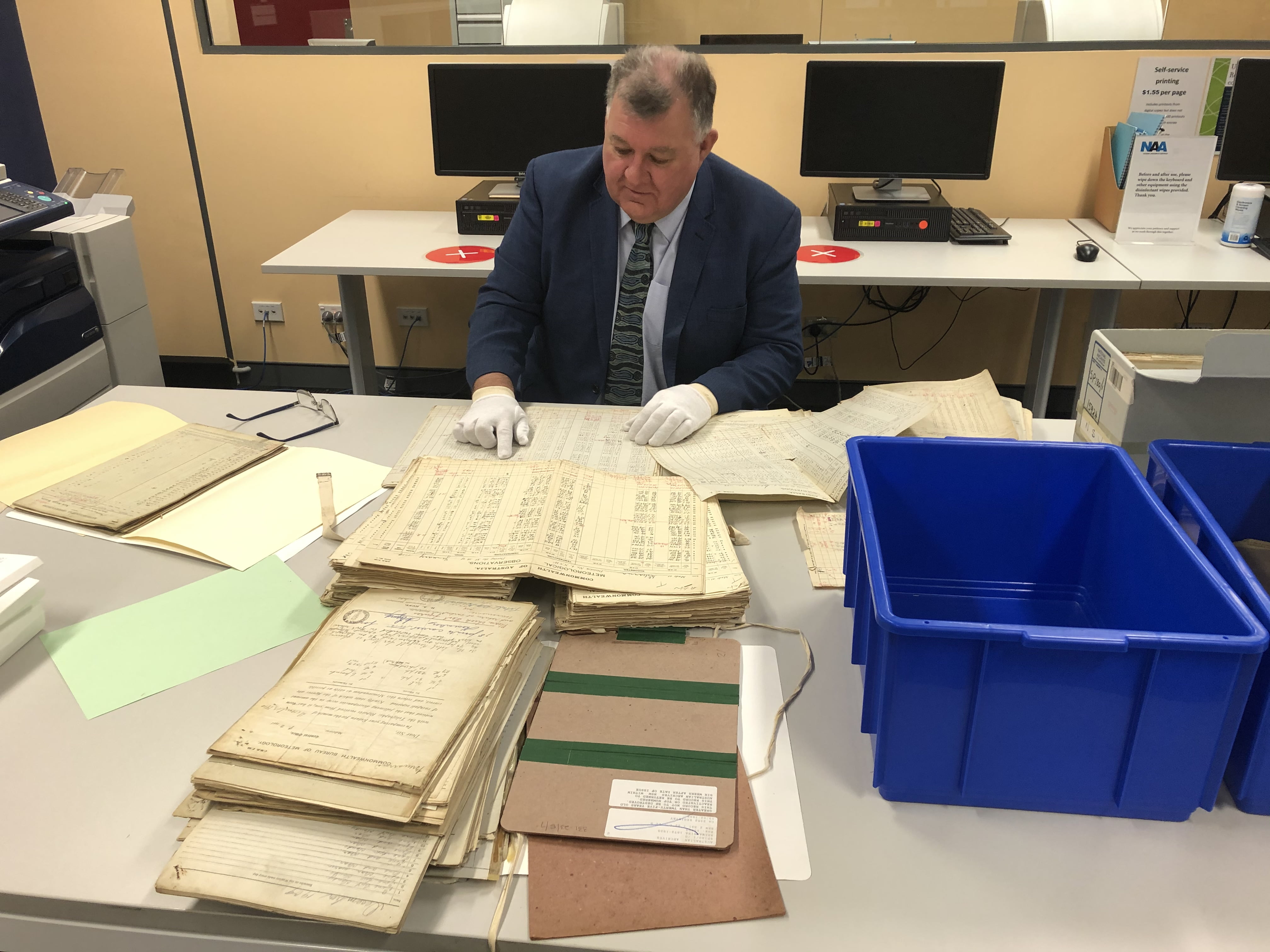
 Jennifer Marohasy BSc PhD is a critical thinker with expertise in the scientific method.
Jennifer Marohasy BSc PhD is a critical thinker with expertise in the scientific method.

I am very pleased to hear a member of parliament is working to correct this misinformation!!! The number of Occassions , in which the BOM , have done this , makes it clear , it is no accident . This is totally inexcusable behaviour , byBOM . They are paid to keep accurate records , so scientists can improve their knowledge , what the BOM are doing is sabotaging science !!!!!
Craig Kelly is one of the best pollies in Australia. Of course he hasn’t got much competition.
Thank you ! Craig for the research ( a word which is strange to the public service language these days) and,
Thank you ! Jennifer for helping and publishing this.
Well done again !!!
With finding / re-discovering of this accidentally overlooked evidence I strongly suspect that there are many other equally “high” or “record” temperatures that have been deleted (oops sorry,, overlooked) by the bureau in digitising and including historical data in their “modern” records.
I wonder who the person was that intentionally left it out, or rather who told them to not include it,,
A royal commission would be an excellent way to investigate what my industry calls “Falsification of records”. Just to find out the Who, What, When & Why of the offense(s), and how many more have been falsified.
BTW, I ordered two copies of the latest bombshell book on Climate alarm-ism, “Apocalypse Never”..cant wait for it to be delivered soon.
watched some vids on the net this week, looks like it got some attention.
I also saw some expected denials of the intention of the book and blatant non-news , non-reporting on the ABC and most of the other networks,,too scared i suspect.
I hope Craig has some time to keep examining those historical records and finds many more instances of the same cover-up (overlooking of high temp records).
It will show a pattern of intentional and systematic abuse of power if you can find the data.
From my experience, once you find a few non-conformances of a similar systematic interference in data recording & reporting then there are more.
It doesn’t happen by accident or a one-off error, EVER.
Looking forward to the next bunch of records being exposed.
they will be there.
thanks again you two heroes.
kind regards, Ed
Brilliant detective work. The elites have damaged the integrity of many institutions including the BOM.
The BoM online database shows the following:
Bourke PO (48013, starting in 1871):
3 Jan 1909: – [paper record: 125 = 51.7 deg C]
4 Jan 1909: 45.3 (2 days) [paper record: 113.5 = 45.3 deg C]
Brewarrina Hospital (48015, 91 km from 48103, only starting in 1965):
3 Jan 1909: – [paper record: 123 = 50.6 deg C]
4 Jan 1909: – [paper record: 117.5 = 47.5 deg C]
The metadata says the Mercury thermometer was installed Jan 1929, and your first photo shows observations made in Jan 1909.
Cobar PO (48030, the next closest station at 157 km from 48013, starting in 1881):
3 Jan 1909: 42.2
4 Jan 1909: 47.2
Apart from hot days being removed (or not included in the public database) and incomplete metadata, there seems to be many undigitised paper records in the archive. (One reason for ACORN-SAT V2 is “further digitisation of historical data” – p.2, BoM Research Report 032.) These should all be neatly scanned in and digitised at once, which will then reveal the true historic ranking of recorded hot and cool days.
****
Thanks Jaco, to be clear, the the online database does not have a value for 3 January 1909 for Bourke. Jen
Great work. How many other hidden gems in those archives, and why hasn’t BOM done this job themselves?
Thanks to Jo Nova for republishing this blog post: http://joannenova.com.au/2020/07/hottest-day-recorded-and-deleted-in-australia-was-51-7-in-bourke-in-1909/
Also, importantly, Blair Trewin’s thesis, falsely claiming an ‘observational error’, is here:
https://minerva-access.unimelb.edu.au/handle/11343/37475
So much thanks to Charles Rotter for republishing at WUWT: https://wattsupwiththat.com/2020/07/10/hottest-day-ever-in-australia-confirmed-bourke-51-7c-3rd-january-1909/
This example of temperature adjustments, provides the rationale for reviewing the downgrading of the Marble Bar temperature records for the longest period of temperatures over 100° F in the world. Marble Bar as a small country town tourist destination would enjoy that record as a potential encouragement for tourists to visit. The BOM has arbitrarily removed a record that was a further tourist attraction feature for the town.
And also to Ken Stewart for re-posting! https://kenskingdom.wordpress.com/
Great work Jennifer – we just need to get this information out to the nation to make people realize the extent these departments will go to in distorting facts to achieve their own agenda.
Scandalous that BOM are given tax payers money to publish false data.
Sincere thanks to Craig and Jennifer for persisting in uncovering this important data. I do think that an in depth inquiry into the machinations of BOM is overdue. Remember the days when public servants were just that and were proud to be that?
Thanks extremely Jen for trying to keep the bastards honest.
And during the past 230 years there have been many recordings of temps all over the country way in excess of 51.7c that could have been supported simply by running comparisons in Stevenson Screens to see how much difference was regularly the case but now are not even a memory.
In the Sturts Stony Desert in the 1950s, 50c [122f] recorded at station verandas that were built on the same principle as a Coolgardie Safe were not unusual and would have recorded even higher in Stevenson Screens.
I’ve worked in those temperatures but have yet to witness flocks of birds that dropped dead by the thousand as happened in Feb 1791 at Rose Hill, west of Sydney.
To claim 48c as the “hottest ever recorded” in Australia is ridiculous.
The eastern coast of Australia suffered from a savage heatwave in 1896. Temperatures in several NSW locations were in excess of 48 degrees Celsius for 3 consecutive days and above 38 degrees Celsius for over 3 weeks. Overnight temperatures did not drop below 30 degrees Celsius. The official death toll from the savage heatwave was 437.
That the BOM chooses to ignore these earlier “colonial” recordings is par for the course.
Great to see another case where your research cuts through Jen.
BoM have been lying/distorting/obfuscating for years – decades.
From the 1970s and 1980s, I remember references to a temperature of 127° F for Cloncurry (and I thought it was in the 1920s or1930s, but the date was 16 Jan 1889). It turns out that there was a problem – the thermometer wasn’t in a standard Stevenson screen, but in a shelter improvised from a beer crate. The Sydney Morning Herald for 21 Jan 2004 had a story on this observation under the title “Beer crate gauge snubbed”:
https://www.smh.com.au/national/beer-crate-gauge-snubbed-20040121-gdi7em.html
In recent years I was unable to find any reference to this temperature observation, not even a comment that it has been discredited as Australia’s highest-ever recorded temperature. It just disappeared.
This disappearance seems to have gone beyond BOM policy, as expressed in the SHM article, indirectly quoting BOM’s (then) Qld director Jim Davidson – “…the 53.1C reading had not been expunged from the records but would be flagged in the bureau’s database as having been recorded in a different way to standard practice.”
The Australian Bureau of Statistics also has something to say on this in its Year Book Australia 2005 under the heading: “Temperature measurement and the Stevenson screen”
https://www.abs.gov.au/ausstats/abs@.nsf/0/e4d19a717ba99a65ca256f7200832fd6?OpenDocument
“…many pre-1910 temperatures in Australia are not strictly comparable with those measured after that date, and therefore must be used with care in analyses of climate change within Australia.”
The Cloncurry observation has dropped out of sight almost totally, beyond even BOM’s stated policy.
Hi Jen.
What happened to Cloncurry? The following is from the late John Daly’s “What’s Wrong With The Surface Record”.
“Some critics will dismiss individual station records as merely `anomalous’ (in which case most of the non-urban stations would have to be dismissed on those grounds), but when one station acquires an importance far beyond its own little record, no effort is spared to discredit it. This was the fate of Cloncurry, Queensland, Australia, which holds the honour of having recorded the hottest temperature ever measured in Australia, a continent known for its hot temperatures. The record was 53.1°C set, not in the `warm’ 1990s, but in 1889. It was a clear target for revisionism, for how can a skeptical public be convinced of `global warming’ when Cloncurry holds such a century-old record? The attack was made by Blair Trewin of the School or Earth Sciences at the University of Melbourne [27], with ample assistance from the whole meteorological establishment. And all this effort and expense was deployed to discredit one temperature reading on one hot day at one outback station 111 years ago. Stations do matter.”
Website for above comment.
http://www.john-daly.com/ges/surftmp/surftemp.htm
Blair Trewin Reference used by John Daly for above.
27] Trewin, B. Another Look at Australia’s Record High Temperature, Aust. Met. Mag. v.46, p.251, (1997)
The Bourke record is not just confirmed by Brewarrina but by another thermometer in Bourke. Perhaps there was an overlap between old and new sites. Post office and old telegraph station? Five days each of The two records can be seen on the same page in column 2 here.
There is something curious about the date in the top right corner of the page.
https://trove.nla.gov.au/newspaper/page/10638471
Not the first time Bourke recorded high temperatures like that either. Back when it had a different type of screen or possibly at the old telegraph station that may have produced numbers two degrees warmer, it did just that with 127 degrees in 1877. So not only was this temperature backed up by the other thermometer in Bourke, the one at Brewarrina and high temperatures from towns hundreds of miles around it, it also has form for doing this in the distant past.
https://trove.nla.gov.au/newspaper/article/252375260
The weather station in 1909 was located in the back yard o the Bourke Post Office
As were many weather stations at that time.
Blair Trewin believes that the reading for the 3rd of January 1909 is wrong because it was a Sunday and the post office manager was not working that day.
However take a look at this photo of the Bourke Post Office
: https://www.environment.nsw.gov.au/heritageapp/visit/ViewAttractionDetail.aspx?ID=5044737
It was built in 1880 with two stories and lots of rooms. It was not just a post office desk..
I suggest that the post office manager lived on site. Blair Trewin has made an unjustified assumption ! And thus was very able to observe the readings of the tempeature gauge.
Mr Kelly MP needs to raise this issue in Parliament drawing attention to the deliberate alteration of official government records to facilitate the production of fake meteorological records and demand that the officials involved in this fraud be dismissed and the correct met. data be reinstated. The Australian government needs to get a grip and drain the swamp of officials who generate fake data.
Thanks to these guys for reposting: https://shepherdgazette.com/hottest-day-ever-in-australia-confirmed-bourke-51-7c-third-january-1909/
Thanks so much to The Spectator for republishing: https://www.spectator.com.au/2020/07/revealed-the-true-hottest-day-ever-recorded-in-australia/
Regarding the photograph taken on 26th June in 2014 at the Chester Hill archive by Jennifer Marohasy:
(i) the image (according to Jennifer’s caption) shows entries for Bourke, on 03Jan1909.
(ii) four entries can be seen for that date: two in red, and two in black.
(iii) these entries appear to show in order:
112 (in black)
125 (the last two digits written – in red – over the last two digits of the first entry)
112 (written above the first entry, in red: the ‘125’ entry has been double-lined crossed out.
125 (a new line (in black) has been created below, in which 125 is underlined.
(iv) I ask: was the use of red ink required to indicate later changes to original record entries?
(v) The record is something of a ‘dog’s breakfast’.
Further to the image posted by Jennifer, I would ask fellow readers to look at the ‘Dry Bulb.’ and ‘Wet Bulb.’ entries posted for that day – and for the day before and for the day after. The three sets of recorded ‘dry bulb – wet bulb’ readings are unaltered. In my view, it can be seen that the final, ‘125’ added-entry is anomalous to these readings. And yet the underlined 125 entry seems to have been added by the same hand that has made other entries in black ink – but perhaps not all of them.
Q1 How can an ‘original’ maximum temperature entry exceed the ‘dry bulb’ record by 15 degrees?
Q2 Were the entries originally in lead pencil, and subsequently over-written in black ink?
Q3 Which of the ‘corrections’ in red ink were ‘original’ and which were later added?
I would have other questions about the order/authorship of each of the entries, but in the first instance, I must say that the (black-ink) subsequent fourth post of 125 degrees by the original recorder is implausible, given the original dry bulb, wet bulb observations.
Thank you, Jennifer, for posting these records.
Gary,
You are in error.
On 3rd January 1909 the observer only recorded the maximum temperature for that day. Normally they didn’t record anything on a Sunday, but that day he made an exception, given it was an exceptionally hot day!
I have just now uploaded three pages that place the 125F in more context … here: https://jennifermarohasy.com/reinstate-hottest-day/
So, nothing was written over anything on 3rd January 1909, and the wet and dry bulb temperatures you refer to were not taken on that day.
How wonderful to know that there are so many sources of online news!
My suggestions to you is to ditch the mainstream (especially the BBC and ABC … they have no idea how badly they misled you!) and go with those who care enough to publish what is really news worthy … like these guys:
https://beforeitsnews.com/science-and-technology/2020/07/the-hottest-day-ever-in-australia-confirmed-jan-1909-2979206.html
So much thanks also to the IPA for republishing:
https://ipa.org.au/publications-ipa/revealed-the-true-hottest-day-ever-recorded-in-australia
And considering joining this organisation that takes on so many issues that cause so much embarrassment. But what are we, if we shy away from a fight because we are ashamed of what we honestly believe?
Better if we are unsure that we have the discussion. And we don’t have to agree on everything. Even Hayek was of that opinion, https://press.uchicago.edu/books/excerpt/2011/hayek_constitution.html
Anyway, you can make a difference by joining the IPA, it is not that complicated, just click here: https://ipa.org.au/join
Thank you.
Thank you for your reply, Jennifer (July 13, 2020 at 3:24 pm). I’ve now looked at the photos of the ‘more complete’ pages and have gained a better understanding of that close-up image under which appeared the caption: “The Meteorological Observations Book for Bourke for January 1909 records 125°C for 3rd January.”
You wrote in your reply “Normally they didn’t record anything on a Sunday, but that day he made an exception, given it was an exceptionally hot day!” On reading that, I wondered if you were just surmising/guessing at the reason for the entry or whether there was an entry elsewhere (e.g. a note) which supports your explanation.
I can posit another plausible explanation for that lone ‘125’ entry: that it was inserted some time later, possibly at/after the end of the month. You can see that the ‘125’ is underlined. I took that at first to be a mark of emphasis, but now on looking through your photos of the ‘more compete’ pages I see some more entries that are underlined and to me it seems that the underlining indicates the highest/lowest figure recorded for the month.
Please look at the entry for the 25th of that month: The ‘Min. read at 9:00 a.m.’ records 55 degrees and it is underlined. In my view, its being underlined indicates that this is the minimum overnight temperature for the month. On inspection of the month’s temperature minima, this is seen to be the case. Likewise with that ‘125’ figure which is underlined – it is the maximum temperature figure for the month.
So too with the barometric figures: the 19th of January and the 25th of January are both underlined and on inspection it can be seen that they indicate respectively the lowest and highest readings for the month.
So too with the rainfall records: rain was recorded twice for the month, 83 points on the 20th of January and 7 points on the 30th. The figure for the 20th is thus underlined. Interestingly, those 87 points fell the day after the lowest barometric pressure of that month.
To return to the figure of ‘125’ and the fact that it is underlined…
Was it underlined at the time that the ‘125’ was entered, or was it underlined later on, e.g., at the end of the month?
I suggest that the ‘125’ itself might have been entered at some stage after the 4th of January.
It can be seen that the ‘dry bulb’ and ‘Max. read at 3 p.m. or later’ entries for the 4th of January are both underlined and then the underlining is crossed out. With the exception of the ‘125’ temperature figure, they are the highest figures in their respective columns for the month. If I am correct in my understanding of the significance of an entry being underlined, I would presume that they were underlined at the end of the month – you’d hardly underline something as being the highest temperature for the month while still only in the first week.
Likewise, you wouldn’t underline your January 4th figures of 112 (dry bulb) and 113.5 (Max at 3:00 p.m. or later) if directly above this second entry was already the figure: ‘125’. Look, it seems reasonable to conclude that the ‘125’ figure was entered and underlined sometime after the 31st of January, 1909. The question is, ‘By whom?’
I’ve already noted how (by using my computer’s ‘zoom’ function) the entry for the maximum temperature on the 2nd of January, originally black and showing 112, had its last two digits written over in red with 25, thus showing 125. It seems to have been crossed out with two parallel horizontal strokes in red and above it, in red, the figure 112 was reinstated. The shape of the digit ‘5’ (seen in this column for 2nd, 3rd & 4th January) has something of a flourish to it. Interestingly, in the ‘ABSTRACT OF RESULTS’ [see Jennifer’s https://jennifermarohasy.com/reinstate-hottest-day/ ] one sees a similar flourish. If I understand that form’s instructions, entries were to be made by someone other than the person who made the original observations in Bourke.
Given the above issues, I must say that I am of the view that ‘125’ figure should be treated with some caution. I think you’ve written that BoM explained not showing it in present day ‘Daily Maximum Temperature’ records for Bourke on the grounds of ‘observational error’ Perhaps BoM was euphemistically covering over its conclusion that the ‘125’ recording was inserted well after the fact.
Thank you again for your reply/response to my comment.
Jen,
Just been reading a book called ‘The Wonders of the Weather’ by Bob Crowder who was Deputy Director of the BoM (retired 1988). It was printed in 1995 with a second edition in 2000.
On page 98 are details of Aust extreme temps. It claims Bourke had a temp of 52.8c on 17th Jan 1877 though it is marked with ‘original record not available for verification’ and ‘non-standard instrumentation’. The BoM data has daily temps for 1877 but not for January – so I wonder why it was listed.
BTW, the Cloncurry record of 53.1C is listed and is shown with no problem with either the verification or instrumentation.